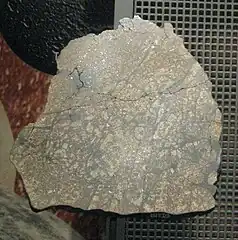L chondrite
The L type ordinary chondrites are the second most common group of meteorites, accounting for approximately 35% of all those catalogued, and 40% of the ordinary chondrites.[1] The ordinary chondrites are thought to have originated from three parent asteroids, with the fragments making up the H chondrite, L chondrite and LL chondrite groups respectively.[2]
| L chondrite | |
|---|---|
| — Group — | |
 NWA 869, an L4-6 chondrite | |
| Type | Chondrite |
| Structural classification | ? |
| Class | Ordinary chondrite |
| Subgroups |
|
| Parent body | Possibly 433 Eros, 8 Flora or the Flora family as a whole |
| Composition | Olivine (characteristic fayalite (Fa) of 21 to 25 mol%), hypersthene (an orthopyroxene), iron–nickel 4–10%, troilite, chromite, Na-rich feldspar, Ca-phosphates |
| Petrologic type | 6 (>60%) |
| Alternative names | L chondrite meteorites, Hypersthene chondrites, Olivine hypersthene chondrites |
 Walters, an L6 chondrite | |
Name
Their name comes from their relatively low iron abundance, with respect to the H chondrites, which are about 20–25% iron by weight.
Historically, the L chondrites have been named hypersthene chondrites or olivine hypersthene chondrites for the dominant minerals, but these terms are now obsolete.
Chemical composition
Characteristic is the fayalite content (Fa) in olivine of 21 to 25 mol%. About 4–10% iron–nickel is found as a free metal, making these meteorites magnetic, but not as strongly as the H chondrites.
Mineralogy
The most abundant minerals are olivine and hypersthene (an orthopyroxene), as well as iron–nickel and troilite. Chromite, sodium-rich feldspar and calcium phosphates occur in minor amounts. Petrologic type 6 dominates, with over 60% of the L chondrites falling into this class. This indicates that the parent body was sizeable enough (greater than 100 kilometres (62 mi) in diameter) to experience strong heating.[3]
Ordovician meteor event
Many of the L chondrite meteors may have their origin in the Ordovician meteor event, radioisotope dated with uranium-lead method at around 467.50±0.28 million years ago. Compared to other chondrites, a large proportion of the L chondrites have been heavily shocked, which is taken to imply that the parent body was catastrophically disrupted by a large impact. This impact has been dated via cosmic ray exposure at around 468.0±0.3 million years ago.[4][5] Earlier argon dating placed the event at around 470±6 million years ago.[6][7]
Parent body
The parent body/bodies for this group are not known, but plausible suggestions include 433 Eros and 8 Flora, or the Flora family as a whole. 433 Eros has been found to have a similar spectrum, while several pieces of circumstantial evidence for the Flora family exist: (1) the Flora family is thought to have formed about 1,000 to 500 million years ago; (2) the Flora family lies in a region of the asteroid belt that contributes strongly to the meteorite flux at Earth; (3) the Flora family consists of S-type asteroids, whose composition is similar to that of chondrite meteorites; and (4) the Flora family parent body was over 100 kilometres (62 mi) in diameter.
See also
References
- "Natural History Museum, meteorite catalogue". Archived from the original on 2006-05-03. Retrieved 2005-12-18.
- NASA (YouTube) – Dr. David Kring – Asteroid Initiative Workshop Cosmic Explorations Speakers Session
- D. Nesvorný et al. The Flora Family: A Case of the Dynamically Dispersed Collisional Swarm?, Icarus, Vol. 157, p. 155 (2002).
- Lindskog, A.; Costa, M. M.; Rasmussen, C.M.Ø.; Connelly, J. N.; Eriksson, M. E. (2017-01-24). "Refined Ordovician timescale reveals no link between asteroid breakup and biodiversification". Nature Communications. 8: 14066. doi:10.1038/ncomms14066. ISSN 2041-1723. PMC 5286199. PMID 28117834.
A zircon U–Pb date of 467.50±0.28 Ma from a distinct bed within the meteorite-bearing interval of southern Sweden that, combined with published cosmic-ray exposure ages of co-occurring meteoritic material, provides a precise age for the L chondrite breakup at 468.0±0.3 Ma
- Schmitz, Birger; et al. (2019-09-18). "An extraterrestrial trigger for the mid-Ordovician ice age: Dust from the break-up of the L-chondrite parent body". Science Advances. 5 (9): eaax4184. doi:10.1126/sciadv.aax4184. PMC 6750910. PMID 31555741.
- H. Haack et al. Meteorite, asteroidal, and theoretical constraints on the 500-Ma disruption of the L chondrite parent body, Icarus, Vol. 119, p. 182 (1996).
- Korochantseva et al. "L-chondrite asteroid breakup tied to Ordovician meteorite shower by multiple isochron 40Ar-39Ar dating" Meteoritics & Planetary Science 42, 1, pp. 3–150, Jan. 2007.
External links
- The Catalogue of Meteorites Archived 2006-05-03 at the Wayback Machine